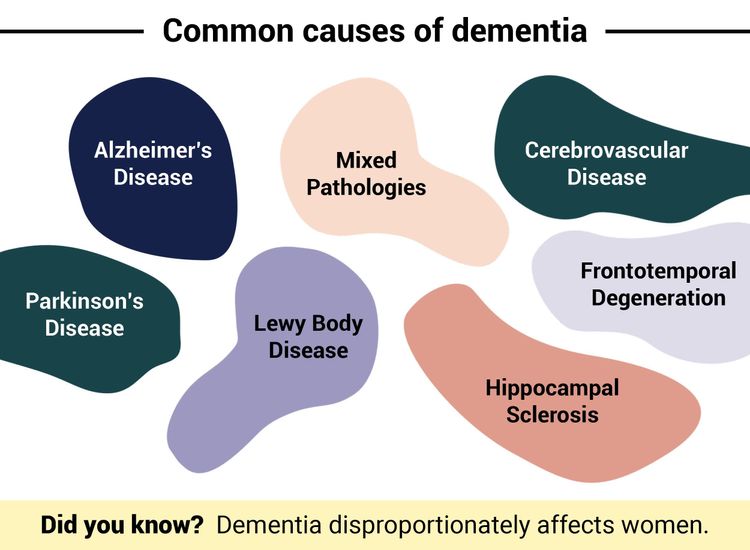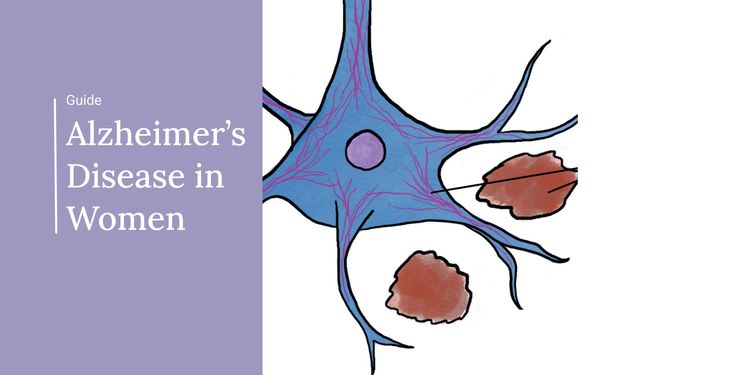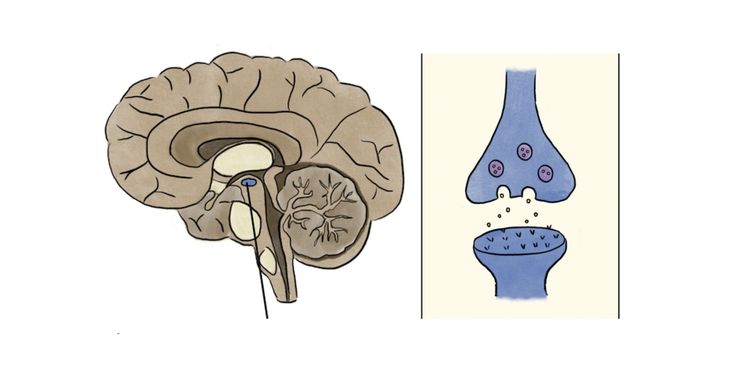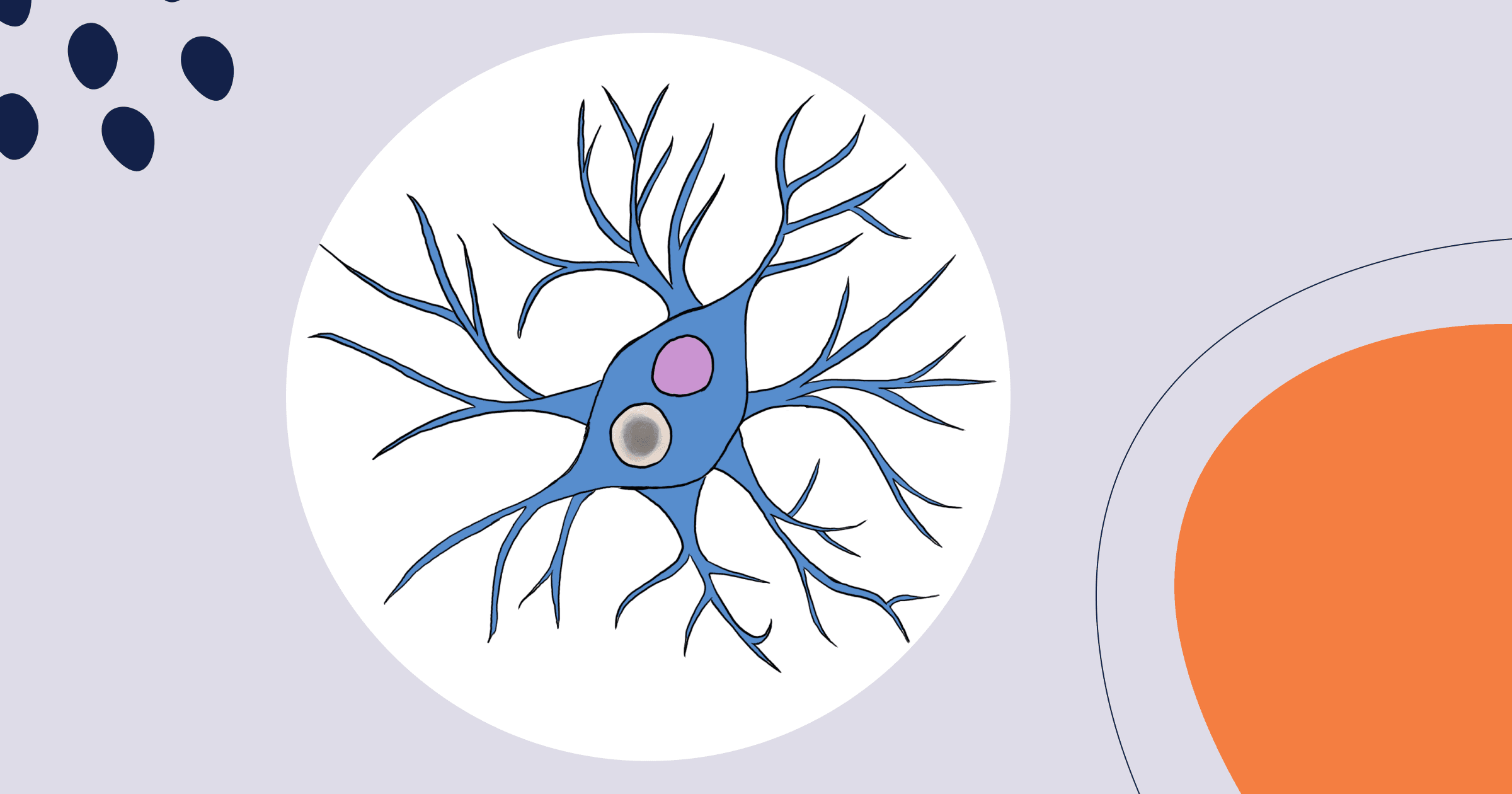
Mar 22, 2024, 4:00 am UTC
5 min
Created by
Q&A: The dementia hardly anyone talks about
A scientist shares emerging research on how Lewy body dementia affects females—and why a deeper dive into sex differences in this common types of dementia is urgently needed.
Lewy body dementia (LBD) is a surprisingly common and deeply impactful neurodegenerative disease. Yet, everywhere from the laboratory to the clinic, it is overshadowed by Alzheimer's disease—a more common cause of dementia. As a result, urgent questions about LBD remain unanswered, including what causes the disease, who's most at risk, and how to treat it.
While LBD affects both men and women, emerging research suggests that there may be distinct differences in how the disease manifests and progresses in females. Yet, what factors contribute to those differences is still unknown.
 Ece Bayram, M.D., Ph.D.
Ece Bayram, M.D., Ph.D.LBD is characterized by the accumulation of abnormal protein deposits, known as Lewy bodies, in the brain. These deposits disrupt normal brain function, leading to a range of changes in thinking, behavior, movement, and sleep that set it apart from Alzheimer’s and other neurodegenerative diseases, including visual hallucinations.
This Q&A with LBD expert Ece Bayram, M.D., Ph.D., Assistant Project Scientist in the Department of Neuroscience at the University of California, San Diego, explores the ways in which the dementia affects females, both biologically and socially, and the remaining gaps in our understanding.
This interview has been edited for length and clarity.
wmnHealth: What led you to study Lewy body dementia, including potential sex and gender differences?
Ece Bayram: I've been working on movement disorders since my PhD days and really like the Parkinsonian community. And I realized there's absolutely nothing on Lewy body dementia.… No one knows about it. No one talks about it. Alzheimer's tends to get the spotlight, as it should, but other dementias deserve the spotlight, too.
I started working on sex differences in Parkinson's first because one of my mentors was interested in it. Then, I realized there's not much known about sex and gender differences in Lewy body dementia. It's striking because it's such a common type of dementia. Plus, you see sex differences in Alzheimer's; you see them in Parkinson's. Lewy body dementia is this type of dementia that stands at the crossroads of those two diseases, so there's likely going to be some sex differences there, too.
From our first paper on Lewy body dementia, it was so striking, so marked how things look so different for females and males. And once I started focusing on this topic more, I started seeing the cracks in the field.
wmnHealth: Based on current data, males are more likely to be diagnosed with Lewy body dementia than females. But not all studies have found a big difference, correct?
Bayram: Yes, especially in Asian countries. For some reason, movement disorders look so different in Eastern versus Western populations. That sex difference is very prominent in the Western population when it comes to the prevalence of Lewy body pathology and disease, but it's not as marked in Eastern populations.
I suspect once the awareness increases, it's going to be kind of like Parkinson's: The prevalence for women and men is not going to be as wildly different as before. I think we need to increase awareness about Lewy body dementia and the fact that women aren't getting represented in research.
wmnHealth: How does Lewy body dementia affect the daily lives of women? Are there unique challenges they face?
Bayram: We really don't know. But I would assume so because in Parkinson's, we know that even when men and women have the exact same disease—the exact same symptoms, disease severity, etc.—the impact on their daily lives may differ. It has to do a lot with gender norms and roles. Based on that, you can easily assume that Lewy body dementia is going to impact women's lives very differently, too.
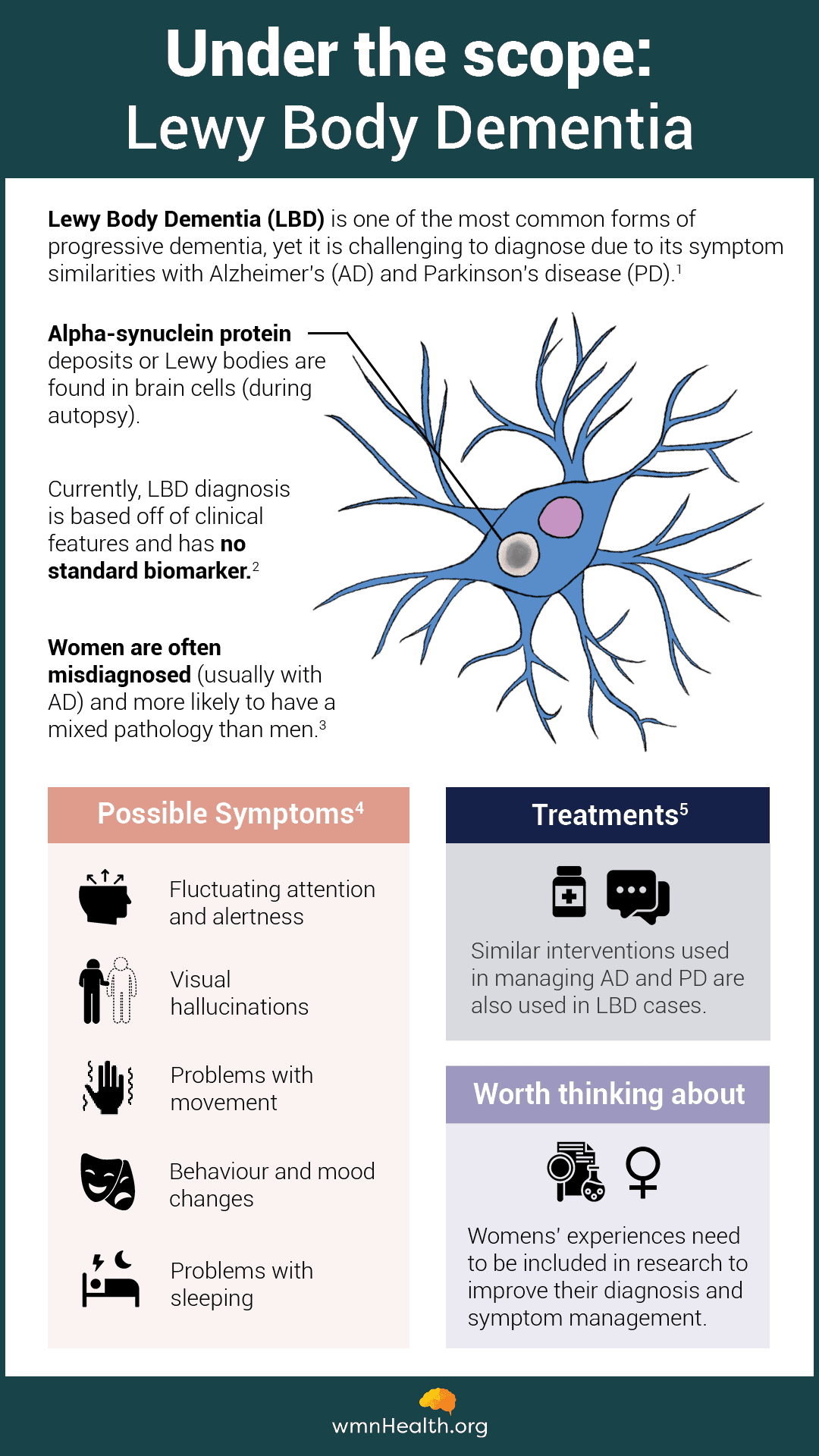 Infographic by Cat Lau. (References below)
Infographic by Cat Lau. (References below)wmnHealth: What's happening in the brains of people with Lewy body dementia?
Bayram: Lewy body dementia is defined by someone having dementia and, when you cut open their brain, Lewy body pathology, in which clumps of proteins called Lewy bodies build up. But Lewy body pathology loves companions. There are many other pathologies that we see alongside Lewy bodies, but I'll touch on Alzheimer's. So, for people with Lewy body pathology, you usually also get the build-up of abnormal tau proteins, which form tangles inside neurons and are one of the hallmarks of Alzheimer's disease. When Alzheimer's tags along with Lewy body dementia, it loves taking center stage. When that happens, especially for women, Alzheimer's really rules the dementia profile.
We don't see Alzheimer's co-pathology as often in males. But the Lewy body pathology just acts naughtier. It causes dementia more for men. It causes Parkinsonism more for men. That's the typical phenotype more for men—the slowness, the shakiness, the stiffness.
wmnHealth: And in females?
Bayram: What's most striking is that females don't look like males. When you look at their brains, they don't have the same pathology, including the degree of build-up of Lewy bodies and tau tangles. So, females may have a bit of resilience to the disease. That's true when you look at brains and also in imaging studies. These sex differences are consistent.
wmnHealth: What about the symptoms? If the pathology differs by sex, do the symptoms, too?
Bayram: Behavioral issues such as visual and auditory hallucinations and depression may be more common for women, whereas motor issues may be more common for men. However, those symptomatic differences may reflect how we diagnose the disease rather than "true" sex differences. For example, much of my research uses pathologically defined cohorts, which means we've confirmed the presence of Lewy bodies in the brain after death. And in those cohorts, I found that women weren't as likely as men to have hallucinations. However, in clinically defined cohorts, which rely on the existing diagnostic criteria, women are more likely to have visual hallucinations.
Common symptoms of Lewy body dementia
- Dementia, especially changes in memory, decision making, problem solving, planning, and abstract or analytical thinking.
- Cognitive fluctuations, such as unpredictable changes in concentration, alertness or attention.
- Parkinson’s-like symptoms including slowness of movement, rigidity or stiffness, shuffling gait, tremors, and balance problems.
- Behavioral changes including hallucinations, delusions or changes in mood.
- Sleep disorders include REM sleep behavior disorder (RBD), excessive daytime sleepiness, temporary loss of consciousness with difficulties wakening, insomnia, and restless leg syndrome.
- Autonomic symptoms, including problems with temperature and blood pressure regulation, as well as constipation, urinary incontinence, and sexual dysfunction.
Source: Lewy Body Dementia Association
wmnHealth: I'm glad you brought up diagnosis because women with Lewy body dementia are often misdiagnosed or diagnosed much later than men. Are the current diagnostic criteria failing women?
Bayram: If women are dealing with more misdiagnosis, more delayed diagnosis, that means the diagnostic criteria are not serving them. So we've got to figure out how the disease actually shows up for women so we can create criteria that better serve them.
The problem is that most of the available data in Lewy body research comes from males. If you're primarily looking at men and saying that this is how they present with Lewy body dementia. Of course, the diagnostic criteria are not going to apply to women. Women aren't represented. So, the things we know right now that drive the treatment plans and the treatment studies, too, come from a problematic sample. There are a lot of voices that get unheard.
wmnHealth: The boundaries of these neurodegenerative diseases are so blurry. Is there a need for biomarkers—objective ways of measuring the signs of disease—that can help clinicians correctly diagnose Lewy body dementia and also distinguish it from Alzheimer's or Parkinson's?
Bayram: Absolutely. In fact, Lewy body dementia is so heterogeneous, even in men, that we are likely missing a huge part of the story. There are some exciting advances in biomarkers, and if we can increase their use, I think we're gonna get better at diagnosing people and also avoiding misdiagnosis. But there has to be combined use of Alzheimer's and Lewy body biomarkers because Alzheimer's so often co-occurs with Lewy body dementia. You cannot exclude Lewy body dementia once you have a positive Alzheimer's test.
wmnHealth: What are you working on now?
Bayram: Right now, I'm focusing on risk factors: Are there different genetic factors driving these sex differences? Are there different environmental factors or reproductive health-related factors driving these differences?
I'm conducting a survey study, sponsored by the Lewy Body Dementia Association, on environmental, occupational, and reproductive health. We're recruiting 50 males and 50 females for a one-time survey that can be filled out online or over the phone. The survey is completely anonymous.
Study: Environmental and Reproductive Health Risk for LBD (LBD – TOROS)
Dr. Bayram is leading the LBD-TOROS study, named after the Toros Mountains near her hometown in Turkey. She is seeking to understand how biological, environmental, occupational, and socioeconomic factors impact the risk of LBD and whether and how the impact risk differs between women and men. Participants who meet the eligibility criteria are welcome.
wmnHealth: What are some of the risk factors you're interested in?
Bayram: In general, people may be exposed to different environmental and occupational factors during their lifetimes based on their gender. Hormones and reproductive health factors look different based on people's sex. Caffeine, alcohol, smoking, history of anxiety, and depression may relate to Lewy body dementia and can differ across sexes and genders. Even when exposed to the same factors, female and male brains may not react the same way. For instance, genetic risk factors like GBA mutations may not increase the Lewy body dementia risk for females despite increasing the risk for males. Reproductive health and environmental history can alter the level of risk in this way, with differences between females and males.
The influence of reproductive health is interesting because, until the ages of 70 to 75, men are more likely to get Lewy body dementia than women. But after the age of 70, 75, there seems to be more of a balance. Women start catching up. Personally, I think that has to do with reproductive health factors like menopause. Of course, women are not going through menopause at 70, but there may be long-lasting effects.
wmnHealth: Are you suggesting women may be buffered against neurodegenerative diseases such as Lewy body dementia for the first 50 years or so, then slowly catch up to men after menopause?
Bayram: It's a hypothesis and one that has important implications for women taking hormone therapies, including people identifying as gender minorities. Environmental factors are also going to differ a lot once for people who identify as a sexual or gender minority, and I want to bring that out because there's nothing that community when it comes to Lewy body dementia. Yet the disease doesn't discriminate.
Infographic References
- What Is Lewy Body Dementia? Causes, Symptoms, and Treatments, The National Institute on Aging. (Accessed March 20, 2024)
- Diagnosis and Prognosis: How is LBD diagnosed? Lewy body Dementia Association (Accessed March 20, 2024)
- Bayram, E., Reho, P., Litvan, I. et al. Genetic analysis of the X chromosome in people with Lewy body dementia nominates new risk loci. npj Parkinsons Dis. 10, 39 (2024).
- Symptoms, Lewy body Dementia Association (Accessed March 20, 2024)
- Treatment Options, Lewy body Dementia Association (Accessed March 20, 2024)
